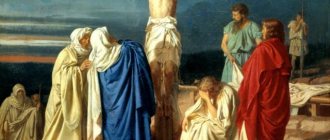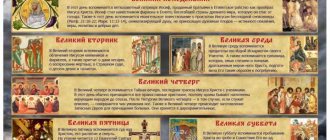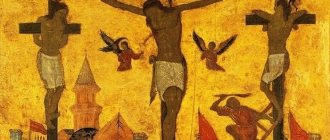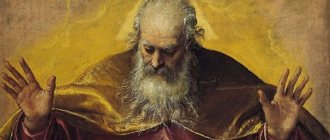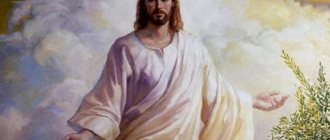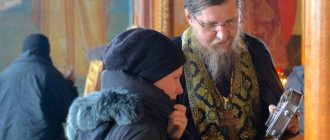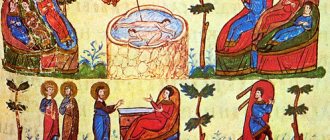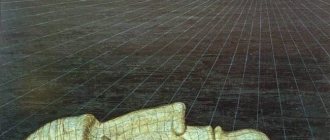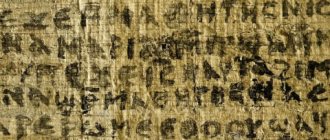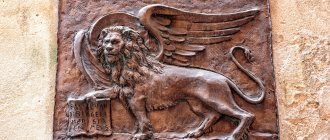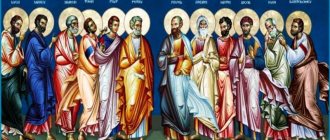| Icon of the Resurrection of Christ |
Easter, Holy Resurrection of Christ
This greatest holiday [1] stands apart from the list of church holidays. As it is sung in the Easter canon, these are the “Feast of Holidays” and the “Triumph of Triumphs.”
The bright holiday of the Resurrection of Christ is called Easter
in internal correlation with the Old Testament holiday of Passover, which, in turn, was so named in memory of the event when, during the exodus of the Jews from Egypt, the angel who destroyed the firstborn of the Egyptians, seeing the blood of the Passover sacrificial lamb on the doors of Jewish homes, passed by (Heb. “ Passover" - lit. "transition", trans. "deliverance"), leaving the firstborn of the Jews inviolable. In accordance with this Old Testament memory, the Feast of the Resurrection of Christ, denoting the passage from death to life and from earth to heaven, received the name Easter.
The meaning of the Resurrection of Christ
With the resurrection of the Lord Jesus Christ from the dead, the Theanthropic feat of salvation and the re-creation of man was completed. The Resurrection was evidence that Jesus Christ is the true God and Lord, Redeemer and Savior. Christ died in the flesh, but His flesh was united into one Hypostasis, unfused, immutable, inseparable, inseparable from God the Word. Christ rose again, for death could not hold in its power the body and soul of Christ, which are in hypostatic unity with the Source of eternal life, with Him who, according to His Divinity, is the Resurrection and Life.
In the Economy of Salvation, the Resurrection of Christ is a manifestation of Divine omnipotence: Christ, after His death, descended “as He desired,” overthrew death, “as God and Master.” He rose on three days and with Himself raised Adam and the entire human race from the bonds of hell and corruption. Having broken the gates (stronghold) of death, Christ showed the way to eternal life.
Jesus Christ rose again as the firstfruits of those who have fallen asleep, the firstborn from the dead (Col. 1:18). Having risen, He sanctified, blessed and approved the general resurrection of all people who will rise from the earth on the general day of resurrection, just as an ear grows from a seed.
The Resurrection of the Lord Jesus Christ testifies that He truly is the Son of God - “risen like God.” It revealed the glory of His Divinity, previously hidden under the veil of humiliation.
The body of Jesus Christ rose in glory. A great and saving new creative action takes place in Him. He in Himself renews our nature, which has fallen into decay.
| The Descent of Christ into Hell, Cathedral of Christ the Savior, Moscow |
The resurrection of the Lord completes the victory over sin and its consequence - death.
Death subverted. The ancient condemnation of death is rejected, condemned. The bonds of hell are broken, and we are delivered from the torment of hell. Death after the Resurrection of Christ does not possess those who lived and died piously, for Christ destroyed the power (power) of death by His death and gave life in the Resurrection. Christ has risen, having conquered death. But even after His Resurrection, death in humanity temporarily continues to claim its victims. But it only melts down the vessels of our soul - the body - to be recreated on the day of resurrection in a new, spiritually renewed form. And since flesh and blood cannot inherit the Kingdom of God and corruption does not inherit incorruption, then our mental-physical life is only a grain for sowing, which must rot - in death - in order to give an ear - new life. Our corruption in death is the path to incorruption. Just as Christ died in the flesh and came to life in the Spirit, so we are freed by Him from the law of sin and death according to the law of the Spirit and life in Him (Rom. 8:2).
Through His Resurrection, Christ made us conquerors of death, and by life in Christ we receive the first fruits of the immortality granted by His resurrection to our mortal nature: “Let no one fear death,” exclaims St. John Chrysostom, “for the death of our Savior will set us free.”
That is why the soul of a Christian is so enthusiastic on the day of Holy Easter: the saving and radiant night of the Resurrection of Christ is the herald of the future day of general resurrection. This is truly a great Easter, Easter, which opens the doors of heaven to us, for death passes away, incorruption and eternal life appear.
Was it possible to “rewrite” the New Testament?
Sometimes we hear that the New Testament was “rewritten many times” or even “edited to please the church leadership.” We can absolutely say that this is not the case. New Testament texts were copied by hand in numerous copies and widely distributed throughout the then civilized world. Imagine yourself in the shoes of a supposed “church leadership” who is faced with the task of making changes to all existing New Testament manuscripts, as well as all manuscripts in which the relevant New Testament passages are mentioned or quoted, plus, in addition to this, somehow “editing” the memory of people who reverently read these texts and, of course, remembered what was written in them. Any such attempt would certainly cause unrest and protests on such a scale that history could not help but preserve them in memory, so that the very fact of editing the texts would be obvious.
Heretics can also act as unwitting witnesses to the authenticity of the New Testament text. Extensive polemical works have reached us, from which it is clear that opponents of the Church, although they offered their own interpretations of the New Testament texts, as a rule, did not dispute their very content. The debate was not about what was written in the New Testament, but about how to understand it.
The “editing” version is also rejected by the data of textual criticism - a thorough study of more than five thousand manuscripts that have reached us. These manuscripts were created at different times, in different places, and sometimes you can find various clerical errors or mistakes made by copyists. All these clerical errors have been carefully taken into account and do not have any impact on the doctrinal content of the text. However, they show that the text was certainly not subject to central editing, which would have eliminated any discrepancies.
Another evidence of authenticity is the “inconvenient” details of the story, which the editor would definitely have removed. Thus, women are the first to meet the Risen One; This does not particularly strike us, but in the ancient world this was an extremely unpleasant detail - women were not considered reliable witnesses, and even in court their testimony was not taken seriously.
history of the holiday
Easter is the oldest holiday of the Christian Church. It was established and celebrated already in apostolic times. Probably, the circle of holidays of the Ancient Church until the century was limited to Sunday. Hardly in the words of the ap. Paul: “Our Passover, Christ was devoured for us; by the same token, let us not celebrate with kvass” (1 Cor. 5:7-8) one can see an indication of the Christian Easter as opposed to the Jewish one. Rather, such an indication can be seen in the care with which St. John the Theologian notes the coincidence of the death of Christ with the Jewish Passover (John 19:4; John 18:28. Compare John 13:1). The insistence with which Christian tradition has always attributed the establishment of Great Lent to the apostles themselves allows us to look for at least its beginnings in that time. It is possible that the words of the Savior: “When the bridegroom is taken away from them, then they fast,” cited by Tertullian as a possible basis for Great Lent, were understood in this sense by the apostles themselves and encouraged them to annually sanctify fasting, which they generally loved (Acts 13 ,2), the day of the death of the Lord. Since this day fell on the Jewish Passover, when the observance of Jewish holidays ceased among Christians, the latter could easily come to the idea of sanctifying the day of the Jewish Passover with fasting in remembrance of the death of Christ. Easter of Christ originally existed in the form of such fasting, as can be seen from the testimony of St. Irenaeus of Lyons (c.).
| The appearance of Christ to the disciples in the village of Emmaus, Refectory Church, Kiev Pechersk Lavra |
Even in the 3rd century.
Christian Easter was reduced to fasting, it was “Easter of the Cross”, along with which Easter of the Resurrection had just begun to act as an independent holiday - under the guise of the solemn end of the Easter fast. During the time of the apostles, this fast was probably left by some on the very day of Passover, and by others on the following Sunday. According to Socrates (5th century), Christians who celebrated Easter on the 14th day of the month of Nisan (i.e. on the same day as the Jews) claimed that this was handed down to them from the Apostle John, and those who celebrated Easter on the following day Easter Sunday they said that they received their custom from St. Peter and Paul. “But neither one nor the other,” notes the ancient historian, “can provide written evidence of this” [2].
In this regard, an important passage from the letter of St. Irinea, bishop Lyonsky, to the Roman bishop. Victor, preserved by Eusebius of Caesarea. It sheds light on the original nature of the Easter holiday. The message was written regarding the disputes about the time of celebrating Easter, which began during the reign of St. Polycarpe, bishop Smyrna (+167), which caused a series of councils and continued with even greater force under St. Irenaeus (+ 202). The disputes concerned the question: to celebrate Easter together with the Jewish one (on the 14th - 15th day of the first spring lunar month) or on the first Sunday after this day.
Excerpt from the text of St. Irenea shows that the dispute about the time of Easter arose because by this time the nature of the holiday itself and the view of it gradually began to change. If earlier Easter was looked upon as a fast in honor of the death of the Savior, who died precisely on the day of the Jewish Passover, now they wanted to combine with it the joyful memory of the Resurrection of Christ, which could not be combined with fasting and was more suitable not for any day of the week, but for which fell on the Jewish Passover, and on Sunday.
In Rome, Easter of Christ began to acquire this character very early, while in Asia Minor church life did not move with such speed, and the original ancient view of Easter remained longer. Therefore, the bishops of the West and the East simply did not understand each other.
| Resurrection of Christ |
St. Irenaeus of Lyons wrote: “They disagree not only about the day, but also about the very image of fasting (a clear indication that the “day”, i.e. Easter, was honored and celebrated precisely by fasting - note by M. Skaballanovich);
It is precisely some who think that you need to fast only one day, others two days, others even more; some calculate their day at 40 hours of day and night. Such a difference in observance did not occur in our time, but much earlier among our ancestors, who probably did not observe great precision in this and passed on their simple, private custom to their offspring. Nevertheless, they all maintained peace, and we live in peace among ourselves, and disagreement regarding fasting (again, not a “holiday”) affirms the agreement of faith” [3]. To this passage from St. Irenaeus Eusebius adds his story about the dispute regarding Easter at St. Polycarpe, when, during the latter’s visit to the Roman bishop. Anikita, their disagreement became clear both on this issue and on others, then “both of them did not argue much with each other regarding other subjects, but immediately agreed, but they did not want to argue about this issue, because neither Anikita could to persuade Polycarp not to observe what he had always observed while living with John, the disciple of our Lord; Neither Polycarp convinced Anicetas to observe, for Anicetas said that he was obliged to preserve the customs of the presbyters who preceded him.”
After St. Polycarp's defender of Asia Minor practice regarding the time of Easter was Melito, bishop. Sardinian, who wrote “Two Books of Easter” (c. 170). Her (literary) opponents were Apollinaris, Bishop. Hierapolis, Clement of Alexandria and St. Hippolytus, Bishop Roman. Councils were held in Palestine, Rome, Pontus, Gaul and Greece in favor of Roman practice. Pope Victor (c. 196) threatened the people of Asia Minor with excommunication. The mentioned message of St. Irenaeus had the goal of reconciling the warring parties. Apparently, the dispute continued until the Council of Nicaea (325), which adopted the Roman practice as universal. The council's definition of Easter has not reached us. Since ancient times, Orthodox Local Churches have determined the date of Easter celebration according to the so-called Alexandrian Paschal: on the first Sunday after the Paschal full moon, between March 22 and April 25.
In 341, the Council of Antioch ordered the excommunication from the Church of “those who celebrate Easter with the Jews” (Canon 1). The custom of fasting on Easter is also exposed by St. John Chrysostom.
Archeology and the New Testament
Excavations carried out in Jerusalem have revealed a number of confirmations of the Gospel story. Thus, back in the 19th century, the pool of Bethesda was found, which is discussed in the Gospel of John (see John 5:2). In 1961, in the ruins of Caesarea in Palestine, an ancient city located on the Mediterranean coast of modern Israel, the so-called “Pilate Stone” was discovered - a limestone block on which the inscription was preserved:
Photo by Marion Doss/Flickr
[…]S TIBERIEV
[PO]NTIVS PILATVS
[PRAEF]ECTVS IVDA[EA]A
This means in translation "... Tiberium. [Pontius Pilate. [Pre]fect of Judas."
In this case, Tiberium is the name of a public building built by Pontius Pilate and dedicated to the Roman Emperor Tiberius, while the city where the inscription was found was named after his predecessor Caesar Augustus - Caesarea.
Also relatively recently, in the 90s of the 20th century, during excavations in Jerusalem, the burial of the high priest Caiaphas, one of the characters in the gospel events, was discovered.
Some time ago, skeptics disputed the gospel account, saying that the Romans tied the condemned to crosses rather than nailing them to death, as the Bible implies. It was quite difficult to refute this, due to the fact that nails were usually not left in the bodies of those executed - partly due to the high cost of iron, partly due to the fact that objects used in executions were often used for superstitious “healing”. However, in 1968, in Givat HaMivtar, a northern suburb of Jerusalem, the burial of Yehohanan, a Jew executed by the Romans at the age of about 30, was found. A huge nail was stuck in the leg bones, so bent (probably due to a knot in the wood of the cross) that they could not pull it out. This discovery showed that the crucifixion was exactly as described in the Bible.
Another depiction of the crucifixion is a caricature discovered in 1857, scratched into the wall of an ancient barracks near the Palatine Hill in Rome. The drawing schematically depicts a crucified with the head of a donkey and a man bowing before him, and the inscription in rough Greek says: “Anaxomenes prays to his God.” Obviously, some Roman legionnaire ridiculed his Christian colleague in this way.
During excavations in Corinth in 1929, archaeologist T. L. Shear discovered a sidewalk with the inscription ERASTUS PRO: AED: S: P: STRAVIT (“This sidewalk was laid at his own expense by Erastus, the custodian of public buildings”). Apparently, this is the same “Erastus, the city treasurer”, whom the holy Apostle Paul mentions in his letter to the Romans (see 16:23).
More recently, in 2008, archaeologists discovered a cave that, by many indications, is the first Christian church discovered to date. The cave is located under the ruins of the ancient church of St. George, which was erected around 230 AD in the city of Rihab, in what is now Jordan.
In the cave, archaeologists discovered seats for clergy, an apse and an altar. According to Abdul Kader Hussain, head of the Rihab Center for Archaeological Research, it was used for worship before 70 AD, possibly starting in 33 AD, when Christians began to be persecuted in Jerusalem (The Jordan Times - Ed.)
Easter service
| The appearance of Christ to Mary Magdalene after the resurrection, A. Ivanov, 1835 |
The divine glory of the Risen Lord and the greatness of the bright holiday of Easter correspond to the high and special solemnity that accompanies the services on the first day of Easter and throughout Bright Week. Since the time of the Apostles, the Church has celebrated the Easter service at night. Like the ancient chosen people, who were awake on the night of their deliverance from Egyptian slavery, Christians are awake on the sacred, all-celebratory and saving night of the Bright Resurrection of Christ.
Is the plot of the Gospel a repetition of an old myth?
Can we know that Christ really rose from the dead? "No! - many non-believers will exclaim. “It’s a myth, like other myths!” We should probably start with the fact that this is most definitely not a myth.
The word "myth" in our everyday language means "falsehood, fiction"; but if we are talking about “myths of the peoples of the world,” then this word has a different meaning. Myth, as anthropologists understand it, is a symbolic narrative of gods and heroes that takes place in the distant, prehistoric past and explains the origins and structure of the world, social institutions, rituals and customs. Myth is fundamentally ahistorical, and its roots are lost in the indistinguishable darkness of centuries. Let us recall, for example, the Babylonian myth of Marduk, which tells of the war of the gods with the forces of chaos, embodied in the monster Tiamat and her allies. After the victory, Marduk cuts Tiamat's body into two parts: from the lower one he creates the earth, from the upper one - the sky, and from the eyes - the Tigris and Euphrates rivers.
Battle of Marduk and Tiamat. Babylonian plate
The apostles are not telling us a myth - not a story about a deity who defeated the forces of chaos once at the dawn of the universe. They talk about events that they personally experienced: about ... “what we have heard, what we have seen with our eyes, what we have looked at and what our hands have touched, about the Word of life (1 John 1:1).” We may believe them or not, but what they tell has nothing to do with mythology. Personally, I can believe or not believe that Alexander Sergeevich Pushkin was mortally wounded in a duel with Dantes, but the written evidence of contemporaries from which we know about this is in no way myths like the myths about the birth of Zeus or the cosmic battle of Marduk and Tiamat . This is historical evidence: “we were present at such and such events; such and such words were spoken and such and such actions were performed.”
The Apostles' disbelief in the words of their wives; appearance of the Lord to Peter. Third.
OK. 24:9-12; Mk. 16:10-11; OK. 24:34; 1 Cor. 15:5.
The women, returning from the tomb, announced all this, seen and heard, to the eleven Apostles and to all the others. It was Magdalene Mary, and Joanna, and Mary, the mother of James, Salome and others with them, who spoke about this to the Apostles.
Apostle Peter at the Holy Sepulcher.
Joanna announced with others. And their words seemed empty to the Apostles, and they did not believe them.
Mary Magdalene announced to those who were with the Lord, weeping and sobbing, what she saw and heard. But when they heard that He was alive and that she had seen Him, they did not believe.
They did not believe the words of Mary of Jacob and Salome.
But Peter, getting up, ran to the tomb and, bending down, saw the same thing as before, only the shrouds lying; and went back, marveling at what had happened.
After this the Lord appeared to Cephas and Simon Peter.
Crown of Thorns of the Savior
According to Church tradition, Saint Queen Helena received the Crown of Thorns as a gift from the Jerusalem community during her pilgrimage to the Holy Land, after which the shrine was kept in Constantinople.
A literary source testifying to this is a record from 1201 made by the sacristan of the Church of the Mother of God of Pharos, Nicholas Nesaritus, who was the custodian of the most important shrines of the empire and had complete knowledge about them. He gives a detailed description of the Crown, and also, along with other authors, testifies that the Crown of Thorns bloomed annually.
After the capture of Constantinople by the Crusaders, many of its shrines came to Western Europe, where after some time the Crown of Thorns was bought by King Louis IX of France. Now the Crown is kept in the Cathedral of Notre Dame in Paris, and its 64 thorns are in various temples and monasteries of the Christian world.
Holy women at the tomb: Joanna and others. Apparitions of Angels.
OK. 24:1-9.
While Mary Magdalene went to the Apostles, other wives also came to the tomb very early, carrying prepared aromas. It was Joanna along with some others.
The appearance of an angel to the myrrh-bearing women. Good news to the apostles.
And they found the stone rolled away from the tomb, and when they entered, they did not find the body of the Lord Jesus. But when they were perplexed about this, two men suddenly appeared before them in shining clothes; and when they were in fear and had cast their eyes to the ground, they said to them: Why do you seek the living among the dead? He is not here: He has risen. Remember how He spoke to you when He was still in Galilee, saying that the Son of Man must be delivered into the hands of sinful men, and be crucified, and on the third day rise again.
And they remembered His words and, returning from the tomb, announced all this to the eleven Apostles and to everyone else.
Plath of the Blessed Virgin Mary
The robe of the Most Holy Theotokos is the fabric that, according to legend, covered Her on the night of the Nativity of the Savior. The first source known to us that tells about this is the text of the presbyter of the Cathedral of St. Sophia in Constantinople, written in 617. According to him, the Virgin Mary especially kept this Plath throughout Her life, remembering that She was in it on the night of the Nativity of Christ. In 469, Plat was transferred to the temple being built in Blachernae. The further fate of the shrine can be traced quite clearly, and today the Plat is kept in the French city of Chartres.
Particles of the Robe of the Mother of God are found in different places, in particular in the Assumption Cathedral of the Moscow Kremlin and in the Lateran Cathedral of St. John the Baptist in Rome.
Appearance eight: more than 500 brethren on the mountain.
1 Cor.15:6 Matt.28:16-18 Mark 16:16-18
The appearance of Christ to the apostles in Galilee.Balkans. Serbia. XIV century Kosovo. Vysoki Decani Monastery. Altar dome.
Then the Lord appeared to more than five hundred brethren, most of whom are still alive to this day (when St. Paul wrote this to the Corinthians), and some have died.
Among them were eleven students. It was in Galilee on the mountain where the Lord commanded them to go and where they went from Jerusalem.
Seeing the Lord appear, they worshiped Him, a. Others (of course, out of 500) doubted. Approaching them, the Lord Jesus said to them: All authority in heaven and on earth has been given to Me. Whoever believes and is baptized (by baptism) will be saved; and whoever does not believe will be condemned. These signs will accompany those who believe: in My name they will cast out demons; they will speak in new tongues; they will take snakes; and if they drink anything deadly, it will not harm them; They will lay hands on the sick, and they will recover .
Chiton of the Savior
The Robe of the Lord is a garment mentioned in the Gospel. The Georgian Orthodox Church honors this shrine, brought from Jerusalem to Mtskheta and remaining to this day hidden in the foundation of the Mtskheta Patriarchal Cathedral of Svetitskhoveli. At the same time, in the chronicles of the city of Trier (Germany) it is mentioned that the Roman Queen Helen brought part of the Chiton of the Savior from Jerusalem. The early Christian community carefully preserved the shrine and sewed it, like a case, into another fabric. In later times it was given the appearance of clothing worn in Palestine in the 1st century.
In 1978, this Chiton was examined by a Swiss group of specialists. It has been scientifically confirmed that the size of the original part of the Saint Chiton, brought by Queen Helena from Jerusalem, is 30x30 cm.
Other parts of Chiton are located in Georgia and, apparently, in France - in the city of Argenteuil near Paris.
